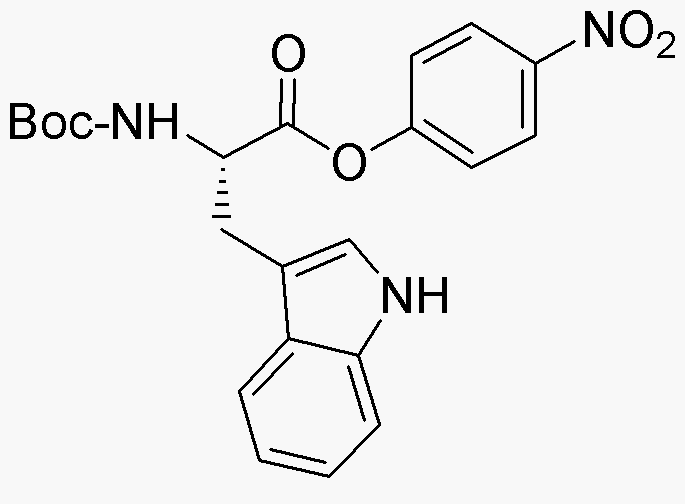Na-Boc-L-tryptophan 4-nitrophenyl ester is widely utilized in research focused on:
- Peptide Synthesis: This compound serves as a key building block in the synthesis of peptides, particularly those involving tryptophan. Its protective Boc group allows for selective reactions, making it easier to construct complex peptide sequences.
- Drug Development: In pharmaceutical research, it is used to create derivatives that can enhance the bioavailability of drugs. The incorporation of tryptophan can improve the pharmacological properties of compounds, making them more effective.
- Bioconjugation: It is applied in bioconjugation techniques, where it helps in attaching biomolecules to surfaces or other molecules. This is crucial in developing targeted drug delivery systems and diagnostic tools.
- Research on Neurotransmitters: Given tryptophan's role as a precursor to serotonin, this compound is valuable in studies exploring neurotransmitter pathways and their implications in mental health and mood disorders.
- Fluorescent Labeling: The nitrophenyl group can be utilized in fluorescent labeling applications, aiding in the visualization of biological processes in live cells, which is essential for cellular and molecular biology research.
Información general
Propiedades
Seguridad y normativas
Aplicaciones
Na-Boc-L-tryptophan 4-nitrophenyl ester is widely utilized in research focused on:
- Peptide Synthesis: This compound serves as a key building block in the synthesis of peptides, particularly those involving tryptophan. Its protective Boc group allows for selective reactions, making it easier to construct complex peptide sequences.
- Drug Development: In pharmaceutical research, it is used to create derivatives that can enhance the bioavailability of drugs. The incorporation of tryptophan can improve the pharmacological properties of compounds, making them more effective.
- Bioconjugation: It is applied in bioconjugation techniques, where it helps in attaching biomolecules to surfaces or other molecules. This is crucial in developing targeted drug delivery systems and diagnostic tools.
- Research on Neurotransmitters: Given tryptophan's role as a precursor to serotonin, this compound is valuable in studies exploring neurotransmitter pathways and their implications in mental health and mood disorders.
- Fluorescent Labeling: The nitrophenyl group can be utilized in fluorescent labeling applications, aiding in the visualization of biological processes in live cells, which is essential for cellular and molecular biology research.
Documentos
Hojas de datos de seguridad (HDS)
La SDS proporciona información de seguridad completa sobre la manipulación, el almacenamiento y la eliminación del producto.
Especificación del producto (PS)
La PS proporciona un desglose completo de las propiedades del producto, incluida la composición química, el estado físico, la pureza y los requisitos de almacenamiento. También detalla los rangos de calidad aceptables y las aplicaciones previstas del producto.
Certificados de análisis (COA)
Busque certificados de análisis (COA) ingresando el número de lote del producto. Los números de lote y de partida se pueden encontrar en la etiqueta de un producto después de las palabras "Lote" o "Lote".
Número de catálogo
Número de lote/lote
Certificados de origen (COO)
Este certificado de origen confirma el país en el que se fabricó el producto y también detalla los materiales y componentes utilizados en él y si se deriva de fuentes naturales, sintéticas u otras fuentes específicas. Este certificado puede ser necesario para cumplir con las normativas aduaneras, comerciales y regulatorias.
Número de catálogo
Número de lote/lote
Hojas de datos de seguridad (HDS)
La SDS proporciona información de seguridad completa sobre la manipulación, el almacenamiento y la eliminación del producto.
DownloadEspecificación del producto (PS)
La PS proporciona un desglose completo de las propiedades del producto, incluida la composición química, el estado físico, la pureza y los requisitos de almacenamiento. También detalla los rangos de calidad aceptables y las aplicaciones previstas del producto.
DownloadCertificados de análisis (COA)
Busque certificados de análisis (COA) ingresando el número de lote del producto. Los números de lote y de partida se pueden encontrar en la etiqueta de un producto después de las palabras "Lote" o "Lote".
Número de catálogo
Número de lote/lote
Certificados de origen (COO)
Este certificado de origen confirma el país en el que se fabricó el producto y también detalla los materiales y componentes utilizados en él y si se deriva de fuentes naturales, sintéticas u otras fuentes específicas. Este certificado puede ser necesario para cumplir con las normativas aduaneras, comerciales y regulatorias.


